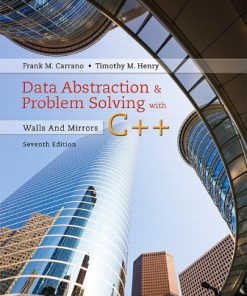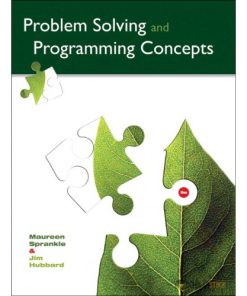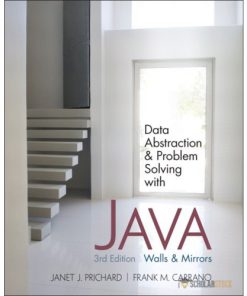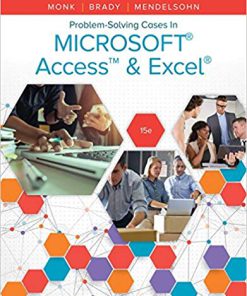Solution Manual for Problem Solving and Programming Concepts, 9/E 9th Edition Maureen Sprankle, Jim Hubbard
$35.00 Original price was: $35.00.$26.50Current price is: $26.50.
Solution Manual for Problem Solving and Programming Concepts, 9/E 9th Edition Maureen Sprankle, Jim Hubbard
Solution Manual for Problem Solving and Programming Concepts, 9/E 9th Edition Maureen Sprankle, Jim Hubbard digital download immediately after payment is complete.

Product details:
- ISBN-10 : 9780132492645
- ISBN-13 : 978-0132492645
- Author: Maureen Sprankle; Jim Hubbard
Problem Solving and Programming Concepts, 9/e, is a core or supplementary text for one-semester, freshman/sophomore-level introductory courses taken by programming majors in Problem Solving for Programmers, Problem Solving for Applications, any Computer Language Course, or Introduction to Programming.
Revised to reflect the most current issues in the programming industry, this widely adopted text emphasizes that problem solving is the same in all computer languages, regardless of syntax. Sprankle and Hubbard use a generic, non-language-specific approach to present the tools and concepts required when using any programming language to develop computer applications. Designed for students with little or no computer experience ― but useful to programmers at any level ― the text provides step-by-step progression and consistent in-depth coverage of topics, with detailed explanations and many illustrations.
Table Of COntents:
Preface UNIT ONE INTRODUCTION TO PROBLEM SOLVING AND PROGRAMMING Chapter 1 General Problem-Solving Concepts Problem Solving in Everyday Life Types of Problems Problem Solving with Computers Difficulties with Problem Solving Summary New Terms Questions Problems Chapter 2 Beginning Problem-Solving Concepts for the Computer Constants and Variables Data Types How the Computer Stores Data Functions Operators Expressions and Equations Summary New Terms Questions Problems Chapter 3 Planning Your Solution Communicating with the Computer Organizing the Solution Introduction to UML (Unified Modeling Language) Using the Tools Testing the Solution Coding the Solution Software Development Cycle Summary New Terms Questions Problems UNIT ONE Supplementary Exercises UNIT TWO LOGIC STRUCTURES Chapter 4 An Introduction to Programming Structure Pointers for Structuring a Solution The Modules and Their Functions Cohesion and Coupling Local and Global Variables Parameters Return Values Variable Names and the Data Dictionary The Three Logic Structures Summary New Terms Questions Problems Chapter 5 Problem Solving with the Sequential Logic Structure Algorithm Instructions, Flowchart Symbols The Sequential Logic Structure Solution Development Summary Questions Problems Chapter 6 Problem Solving with Decisions The Decision Logic Structure Multiple If/Then/Else Instructions Using Straight-Through Logic Using Positive Logic Using Negative Logic Logic Conversion Which Decision Logic? Decision Tables Putting It All Together The Case Logic Structure Codes Putting It All Together Another Putting It All Together Summary New Terms Questions Problems Chapter 7 Problem Solving with Loops The Loop Logic Structure lncrementing Accumulating While/WhileEnd Putting It All Together Repeat/Until Putting It All Together Automatic-Counter Loop Putting It All Together Nested Loops Indicators Algorithm Instructions and Flowchart Symbols Recursion Summary New Terms Questions Problems UNIT TWO Supplementary Exercises UNIT THREE DATA STRUCTURES Chapter 8 Processing Arrays Arrays One-Dimensional Arrays Putting It All Together Two-Dimensional Arrays Putting It All Together Multidimensional Arrays Table Look-Up Technique The Pointer Technique Putting It All Together Summary New Terms Questions Problems Chapter 9 Sorting, Stacks, and Queues Sorting Techniques Stacks Queues Summary New Terms Questions Problems Chapter 10 File Concepts Beginning File Concepts Records as a Data Structure Primary and Secondary Keys Algorithm Instructions and Flowchart Symbols Systems Flowcharts Designing Records Summary New Terms Questions Problems Chapter 11 Linked Lists Creating Linked Lists Examples of Adding Data to/Deleting Data from Linked Lists Algorithms and Flowcharts to Add, Delete, and Access Data in a Linked List Summary New Terms Questions Problems Chapter 12 Binary Trees Creation of Binary Trees Accessing Data in a Binary Tree Traversal of Binary Trees Summary New Terms Questions Problems UNIT THREE Supplementary Exercises UNIT FOUR DATABASE MANAGEMENT SYSTEMS Chapter 13 Database Management Systems Why a DBMS? DBMS Components DBMS Models Client-Server Model DBMS Tasks Summary New Terms Questions Chapter 14 Relational Database Management Systems Tables, Records, and Fields Normalizing Tables Entity Relation Model Schema Creating Tables Queries Interface Design Reports Planning a Solution Using an RDBMS Summary New Terms Questions Problems UNIT FIVE OBJECT-ORIENTED PROGRAMMING Chapter 15 Concepts of Object-Oriented Programming Object-Oriented Programming Graphical User Interface (GUI) Event-Driven Object-Oriented Programming Interactivity Summary New Terms Questions Problems Chapter 16 Object-Oriented Program Design Designing an Object-Oriented Application Interface Design Designing an Event-Driven Object-Oriented Application Summary New Terms Questions Problems UNIT SIX INTRODUCTION TO GAME DEVELOPMENT Chapter 17 Introduction to Concepts of Game Development Using Object-Oriented Programming Game Development Planning the Game Steps to Develop a Simple Game Summary New Terms Questions Problems Chapter 18 Introduction to Assembly Language Assembly Language versus High-Level Languages Assembly Language Concepts Some Basic Assembly Language Instructions Assembly Language Equivalents to the Four Logic Structures Summary New Terms Questions Problems UNIT SEVEN FILE PROCESSING Chapter 19 Sequential-Access File Applications Processing Sequential-Access Files The Primer Read Designing Output Reports Headings and Line Counters Control-Breaks Multiple Control-Breaks Using Indicators for Program Control Error Handling Null Files Summary New Terms Questions Problems Chapter 20 Sequential-Access File Updating Creating Files The Master File Transaction Files Activity Files Backup Files Updating the Master File Using a Transaction File Putting It All Together A Useful Alternative Method Summary New Terms Questions Problems UNIT FIVE Supplementary Exercises APPENDIX A Otto the Robot APPENDIX B ASCII and EBCDIC Codes for Data Representation APPENDIX C Forms to Use in Problem Solving APPENDIX D Other Problem-Solving Tools APPENDIX E Other Functions GLOSSARY INDEX
People also search:
problem solving and programming concepts 9th edition pdf
programming logic and design comprehensive 9th edition answer key
solving and programming concepts, 9th edition
does programming involve math
how does programming enable creativity and individual expression
You may also like…
Solution Manual
Solution Manual for MATLAB: A Practical Introduction to Programming and Problem Solving 5th Edition
Solution Manual
Solution Manual
Solution Manual
Solution Manual for Data Structures and Problem Solving Using Java, 4/E 4th Edition : 0321541405












